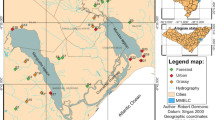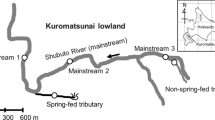Abstract
The abundance of Unio crassus (Philipsson 1788) has declined over the last decades. Despite the high conservation status of this species, knowledge on its ecological requirements is scarce. The objective of this study was to identify key habitat characteristics in areas with recent recruitment of U. crassus in a small upland stream. Furthermore, we investigated stretches where the species is presently absent. Sediment deposition, redox potential, flow velocity, water depth, nitrogen and phosphorus load were investigated. Fine sediment deposition was high with 19.4 kg m−2 month−1 at colonized and 13.3 kg m−2 month−1 at non-colonized stretches of the Sallingbach. At all study stretches, redox potentials in the interstitial zone varied around 300 mV which constitutes the boundary value between oxic and anoxic conditions. Results of chemical water analyses indicated high nitrogen loads. Nitrate nitrogen concentrations averaged between 4.1 and 6.5 mg NO3–N/l at all study stretches, significantly exceeding the currently proposed threshold value of 2.0 mg/l for functional U. crassus streams. The results in this study suggest that U. crassus is more tolerant to eutrophic habitat conditions than previously expected. Our findings show that currently considered physicochemical parameters and high fine sediment deposition cannot mechanistically explain the occurrence of U. crassus in the stream.





Similar content being viewed by others
References
Aarts, B. G. W., F. W. B. Van den Brink & P. H. Nienhius, 2004. Habitat loss as the main cause of the slow recovery of fish faunas of regulated large rivers in Europe: the transversal floodplain gradient. River Research and Applications 20: 3–23.
Abell, R., 2002. Conservation biology for the biodiversity crisis: a freshwater follow-up. Conservation Biology 16: 1435–1437.
Ansteeg, O., 1994. Untersuchung zur Populationsdichte, Bestandsgröße und Altersstruktur der Bachmuschel (Unio crassus) im Sallingbach (Lkr. Kelheim). Erfolgskontrolle im Rahmen des Umsetzungsprojekts “Sallingbachtal”.
Ansteeg, O., 1999. Untersuchung zur Populationsdichte, Bestandsgröße und Altersstruktur der Bachmuschel Unio crassus (PHIL. 1788) im Sallingbach (Lkr. Kelheim).
Ansteeg, O., 2010. Untersuchung zur Populationsdichte, Bestandsgroeße, und Altersstruktur der Bachmuschel Unio crassus (PHIL. 1788) im Sallingbach (Lkr Kelheim). Erfolgskontrolle 2009 im Rahmen des Umsetzungsprojekts „Sallingbachtal“.
Augspurger, T., A. E. Keller, M. C. Black, W. G. Cope & F. J. Dwyer, 2003. Water quality guidance for protection of freshwater mussels (Unionidae) from ammonia exposure. Environmental Toxicology and Chemistry 22: 2569–2575.
Bauer, G., 1988. Threats to the freshwater pearl mussel Margaritifera margaritifera L. in Central Europe. Biological Conservation 45: 239–253.
Björk, S., 1962. Investigations on Margaritifera margaritifera and Unio crassus. Acta Limnologica 4: 109.
Bless, R., 1980. Bestandsentwicklungen der Mollusken-Fauna heimischer Binnengewässer und die Bedeutung für Naturschutz und Landschaftspflege. Biologische Abhandlungen 5: 1–60.
Bogan, A. E., 2008. Global diversity of freshwater mussels (Mollusca, Bivalvia) in freshwater. Hydrobiologia 595: 139–147.
Brandner, J. 1997. Einfluss der Gewaesserstruktur auf die Verteilung des Makrozoobenthos in einem Bach des tertiaeren Huegellandes (Sallingbach). Master Thesis, University of Regensburg, Germany.
Buddensiek, V., H. Engel, S. Fleischauer-Roessing & K. Waechtler, 1993. Studies on the chemistry of interstitial water taken from defined horizons in the fine sediments of bivalve habitats in several northern German lowland waters II: microhabitats of Margaritifera margaritifera L., Unio crassus (Philipsson) and Unio tumidus (Philipsson). Archiv fuer Hydrobiologie 127: 151–166.
Burgin, A. J. & S. K. Hamilton, 2007. Have we overemphasized the role of denitrification in aquatic ecosystems? A review of nitrate removal pathways. Frontiers in Ecology and the Environment 5: 89–96.
Colling, M., 2007. Aktuelle Bestandssituation der Bachmuschel und naturschutzfachliche Bewertung im FFH-Gebiet Sallingbachtal, Untersuchungsphase 2007. Study on behalf of the government of Lower Bavaria.
Dirzo, R. & P. H. Raven, 2003. Global state of biodiversity and loss. Annual Review of Environment and Resources 28: 137–167.
Douda, K., 2010. Effects of nitrate nitrogen pollution on Central European unionid bivalves revealed by distributional data and acute toxicity testing. Aquatic Conservation: Marine and Freshwater Ecosystems 20: 189–197.
Douda, K., P. Horký & M. Bílý, 2012. Host limitation of the thick-shelled river mussel-identifying threats to declining affiliate species. Animal Conservation 15(5): 536–544.
Dudgeon, D., 1992. Endangered ecosystems: a review of the conservation status of tropical Asian rivers. Hydrobiologia 248: 167–191.
Engel, H., 1990. Untersuchungen zur Autökologie von Unio crassus (Philipsson) in Norddeutschland. PhD Thesis, Hannover, Germany.
Eroes, T., Z. Botta-DuKát & G. D. Grossmann, 2003. Assemblage structure and habitat use of fishes in a Central European submontane stream: a patch based approach. Ecology of Freshwater Fish 12: 141–150.
Fleischauer-Roessing, S., 1990. Untersuchungen zur Autoekologie von Unio tumidus PHILIPSSON und Unio pictorum LINNAEUS (Bivalvia) unter besonderer Berücksichtigung der frühen post-parasitären Phase. PhD Thesis, Hannover, Germany.
Geist, J., 2010. Strategies for the conservation of endangered freshwater pearl mussels (Margaritifera margaritifera L.): a synthesis of Conservation Genetics and Ecology. Hydrobiologia 644: 69–88.
Geist, J., 2011. Integrative freshwater ecology and biodiversity conservation. Ecological Indicators 11: 1507–1516.
Geist, J. & K. Auerswald, 2007. Physicochemical stream bed characteristics and recruitment of the freshwater pearl mussel (Margaritifera margaritifera). Freshwater Biology 52: 2299–2316.
Geyer, D., 1927. Unsere Land- und Süßwassermollusken. Lutz, Stuttgart, Germany.
Hastie, L. C., P. J. Boon & M. R. Young, 2000. Physical microhabitat requirements of freshwater pearl mussels, Margaritifera margaritifera (L.). Hydrobiologia 429: 59–71.
Hochwald, S., 1989. Bestandsaufnahme und Schutzvorschläge für die Bachmuschelpopulation (Unio crassus Phil.) im Sallingbach (Lkr. Kelheim). – Auftragsarbeit des Arten- und Biotopschutzprogrammes (ABSP) Landkreis Kelheim im Rahmen des Umsetzungsprojektes Sallingbachtal.
Hochwald, S., 1990. Populationsparameter der Bachmuschel (Unio crassus Phil. 1788) im Sallingbach (Landkreis Kelheim). Schriftenreihe Bayerisches Landesamt fuer Umweltschutz, Heft 97, Muenchen, Germany.
Hochwald, S., 1997. Das Beziehungsgefuege innerhalb der Groeßenwachstums- und Fortpflanzungsparameter bayerischer Muschelpopulationen (Unio crassus PHIL. 1788) und dessen Abhaengigkeit von Umweltparametern. Dissertation, Universitaet Bayreuth, 1997. Bayreuther Forum Oekologie:50.
Hochwald, S., 2001. Plasticity of life-history traits in Unio crassus. In Bauer, G. & K. Waechtler (eds), Ecology and Evolution of the Freshwater Mussels Unionoida. Springer, Heidelberg, Germany: 127–141.
Hochwald, S. & G. Bauer, 1990. Untersuchungen zur Populationsoekologie und Fortpflanzungsbiologie der Bachmuschel Unio crassus PHIL 1788. und dessen Abhaengigkeit von Umweltfaktoren. Bayreuther Forum Oekologie 50: 1–156.
Hus, M., M. Śmialek, K. Zajak & T. Zajak, 2006. Occurence of Unio crassus (Bivalvia, Unionidae) depending on water quality in the foreland of the Polish Carpathians. Polish Journal of Environmental Studies 15(1): 169–172.
Israel, W., 1913. Biologie der europäischen Süßwassermuscheln. K.G. Lutz Verlag, Stuttgart, Germany: 44–47.
Jungbluth, J.H., J. Gerber & K. Groh, 1988. Unio crassus. Ökologische Standortüberprüfung in Bayern. Teil I. (not published, Bayerisches Landesamt für Wasserwirtschaft).
Koehler, R., 2006. Observations of impaired vitality of Unio crassus (Bivalvia, Najadae) populations in conjunction with elevated nitrate concentration in running water. Acta hydrochimica et hydrobiologica 34: 346–348.
Lydeard, C., R. H. Cowie, W. F. Ponder, A. E. Bogan, P. Bouchet, S. A. Clark, K. S. Cummings, T. J. Frest, O. Gargominy, D. G. Herbert, R. Hershler, K. E. Perez, B. Roth, M. Seddon, E. E. Strong & F. G. Thompson, 2004. The global decline of nonmarine mollusks. BioScience 54(4): 321–330.
McRae, S. E., J. D. Allan & J. B. Burch, 2004. Reach- and catchment-scale determinants of the distribution of freshwater mussels (Bivalvia: Unionidae) in south-eastern Michigan, U.S.A. Freshwater Biology 49: 127–142.
Mueller, M., J. Pander, R. Wild, T. Lueders & J. Geist, 2012. The effects of stream substratum texture on interstitial conditions and bacterial biofilms: methodological strategies. Limnologica. doi:10.1016/j.limno.2012.08.002.
Pander, J. & J. Geist, 2010. Seasonal and spatial bank habitat use by fish in highly altered rivers – a comparison of four different restoration measures. Ecology of Freshwater Fish 19: 127–138.
Patzner, R.A. & D. Mueller, 2001. Effects of eutrophication on unionids. In Bauer, G. & K. Waechtler (eds), Ecology and Evolution of the Freshwater Mussels Unionoida. Springer, Heidelberg: 327–335.
Perez-Quintero, J. C., 2007. Diversity, habitat use and conservation of freshwater molluscs in the lower Guadiana River basin (SW Iberian Peninsula). Aquatic Conservation: Marine and Freshwater Ecosystems 17: 485–501.
Reischuetz, P. L. & P. Sackl, 1991. Zur historischen und aktuellen Verbreitung der gemeinen Flussmuschel, Unio crassus Philipsson 1788 (Mollusca, Bivalvia, Unionidae), in Oesterreich. Linzer biologische Beiträge 23: 213–232.
Revenga, C. & Y. Kura, 2003. Status and trends of biodiversity of inland water ecosystems. Secretariat of the Convention on Biological Diversity, Montreal. Technical Series No. 11.
Sala, O. E., F. S. Chapin, J. J. Armesto, E. Berlow, J. Bloomfield, R. Dirzo, E. Huber-Sanwald, L. F. Huenneke, R. B. Jackson, A. Kinzig, R. Leemans, D. M. Lodge, H. A. Mooney, M. Oesterheld, N. L. Poff, M. T. Sykes, B. H. Walker, M. Walker & D. H. Wall, 2000. Global biodiversity scenarios for the year 2100. Science 287: 1770–1774.
Schaelchli, U., 1992. The clogging of coarse gravel river beds by fine sediment. Hydrobiologia 235(236): 189–197.
Schlesinger, W. H., 1991. Biogeochemistry. Academic Press, San Diego, CA.
Seitz, G., 1988. Beschaffenheit der Fließgewässer, wasserwirtschaftliche Daten zum Sallingbach, Lkr. Kehlheim. (not published).
Sinowski, W. & K. Auerswald, 1999. Using relief parameters in a discriminant analysis to stratify geological areas of different spatial variability of soil properties. Geoderma 89: 113–128.
Strayer, D. L., J. A. Downing, W. R. Haag, T. L. King, J. B. Layzer, T. J. Newton & S. J. Nichols, 2004. Changing perspectives on pearly mussels, North America’s most imperiled animals. BioScience 54: 429–439.
Taeubert, J. E., B. Gum & J. Geist, 2012. Host-specificity of the endangered thick-shelled river mussel (Unio crassus, Philipsson 1788) and implications for conservation. Aquatic Conservation: Marine and Freshwater Ecosystems 22: 36–46.
Tudorancea, C. & L. Gruia, 1968. Observations on the Unio crassus (Philipsson) Population from the Nera River. Travaux du Museum d’ Histore Naturelle “Grigora Antipa” 8: 381–394.
Vicentini, H., 2005. Unusual spurting behaviour of the freshwater mussel Unio crassus. Journal of Molluscan Studies 71: 409–410.
von Proschwitz, T. & S. Lundberg, 2004. Tjockskalig målarmussla – en rar och hotad sötvattensmussla [in Swedish]. Fauna och Flora 99: 16–27.
Waechtler, K., M. C. Dreher-Mansur & T. Richter, 2001. Larval types and early postlarval biology in Naiads (Unionida). In Bauer, G. & K. Waechtler (eds), Ecology and Evolution of the Freshwater Mussels Unionoida. Springer, Heidelberg, Germany: 93–125.
Zettler, M. L. & U. Jueg, 2007. The situation of the freshwater mussel Unio crassus (Philipsson 1788) in north-east Germany and its monitoring in terms of the EC Habitats Directive. Mollusca 25: 165–174.
Zettler, M. L., D. Kolbow & F. Gosseck, 1994. Ursachen fuer den Rueckgang und die heutige Verbreitung der Unioniden im Warnow-Einzugsgebiet (Mecklenburg-Vorpommern) unter besonderer Beruecksichtigung der Bachmuschel (Unio crassus, Philipsson 1788) (Mollusca, Bivalvia). Erweiterte Zusammenfassung der Jahrestagung DGL, Hamburg, 2: 597–601.
Acknowledgments
This manuscript is dedicated to Martin Eicher who was the key conservationist for the restoration in the Sallingbach. He passed away in 2012. The authors are grateful for financial support by the Landschaftspflegeverband Kelheim-VöF e.V and acknowledge the support of the TUM Graduate School’s Faculty Graduate Center Weihenstephan at the Technische Universitaet Muenchen.
Author information
Authors and Affiliations
Corresponding author
Additional information
Marco Denic and Katharina Stoeckl contributed equally to this study.
Guest editors: Manuel P. M. Lopes-Lima, Ronaldo G. Sousa, Simone G. P. Varandas, Elsa M. B. Froufe & Amílcar A. T. Teixeira / Biology and Conservation of Freshwater Bivalves
Rights and permissions
About this article
Cite this article
Denic, M., Stoeckl, K., Gum, B. et al. Physicochemical assessment of Unio crassus habitat quality in a small upland stream and implications for conservation. Hydrobiologia 735, 111–122 (2014). https://doi.org/10.1007/s10750-013-1467-z
Received:
Accepted:
Published:
Issue Date:
DOI: https://doi.org/10.1007/s10750-013-1467-z




